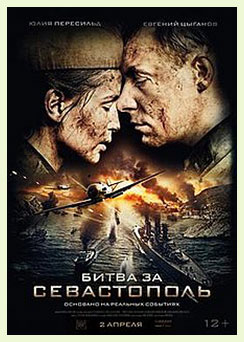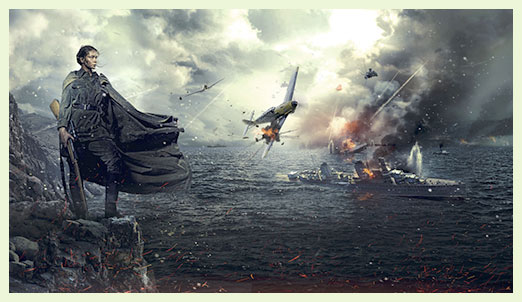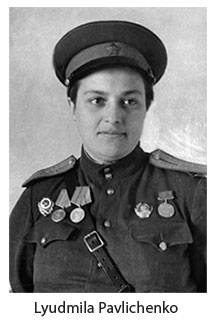A Glimpse into the Other Camp: Sergey Mokritski‘s: Battle of Sevastopol
In the new Cold War that partisan American propagandists have been fomenting the past few years, Russia and Vladimir Putin have taken on an unreality in the popular consciousness akin to the Empire and Darth Vader. The media has morphed them into the opposition forces, faceless envoys of evil in a political narrative only metaphorically related to real people with houses and relations and household pets.

So, it is disorienting to come across a recent film that celebrates a Russian national hero and which does so using heroic iconography and story patterns associated with storytelling in the West. That joint Russian/Ukrainian production is Battle for Sevastopol (2015), not a masterpiece, but a compelling and accurate biography of the celebrated WWII sniper, Lyudmila Mikhaylovna Pavlichenko, who registered 309 confirmed kills, many coming during the brutal defense of the Crimean port city of Sevastopol in 1941 and 1942. The battle delayed German advances but at the cost of over 200,000 Soviet forces which eventually succumbed to the over 46,000 tons of artillery the Axis forces rained upon them. The backdrop of Sevastopol gives Pavlichenko’s story cultural resonance for the Russian people on a level similar to the placement of the Battle of Borodino, the worst of the Napoleonic Wars, in Tolstoy’s War and Peace.
Pavlichenko had a compelling life story that demanded this film, beyond her remarkable marksmanship. She was a bright and attractive university student from a highly respectable family, and an ordinary woman in matters of love and loyalty; but in the course of the war she became a cold-blooded and uber-patriotic killer. And she also became a confidante of Eleanor Roosevelt in the latter stages when she was sent to America to rally support for war funding.
The film’s director, Sergey Mokritski, insisted that the script be carefully researched and as accurate as possible. As result, the film presents “Lady Death” in vulnerable and humane terms. There is no easy explanation for her aptitude, tenacity, success, or tragedy. Even when we get a post-war scene of Pavlichenko at the opera with her son and Mrs. Roosevelt in the film’s denouement, we are spared heavy sentiment and clever resolutions. Not monster nor hero, she is a fully three-dimensional character with a heart and a mysterious soul. Just that honest depiction makes this film worth our curiosity.

The story is told as a series of flashbacks beginning with Roosevelt arriving in Moscow to meet with Nikita Kruschchev, but explaining to her driver that Kruschchev should wait given her stronger desire to visit Pavlichenko. That scene then trips the wire sending the narrative back further to 1942 when Roosevelt first met the heralded sniper with her Soviet managers addressing the American press. Roosevelt becomes intrigued by Pavlichenko’s manner and grit and in an attempt to help her relate better to American audiences she gets from the woman the details of her story, unhappy sequence by sequence. The bond formed between the two is the central motif of the work, women thrust into roles contrary to their natures and suffering their misfortunes together.

Beyond this sisterhood motif, Pavlichenko’s story is not forced into a specific genre pattern, as is typical in American war films like Sergeant York or Saving Private Ryan. Nor is it gratuitous in describing the horrors of war, though we get some rough moments, like “Lady Death” intentionally wounding and not killing a couple “fascists,” just to make them suffer more. In fact, that sequence underscores the story’s irony as she is pulled back to humanity by one of her three, tragic love interests, Leonid.
Beyond the story, Battle for Sevastopol is carried by two special performances. The first is the fine work of the lead, Yulia Peresild, whose face plays well to the camera in love, bitterness, and triumph. She looks the part and becomes the part, challenging here given the task of playing a killer who also looks good as a dance partner. The second is the performance of Mokritski and Yuri Korol, his cinematographer. Much of the film’s success rests on the visual quality of the compositions, be they interior peace-time sets or those with Pavlichenko hunting for the next mark.
A glaring weakness in the work involves some of the dubbing, and some might also complain that the layering of flashbacks is difficult to follow at first. Still, Battle for Sevastopol is a well-made and effective film that tells a story that like life mixes the poignant with the tragic. And it is a film that might pull an American viewer out of the faux realities of current political discourse into the greater discourse between human beings struggling for purpose and understanding in this all too fallen world.
